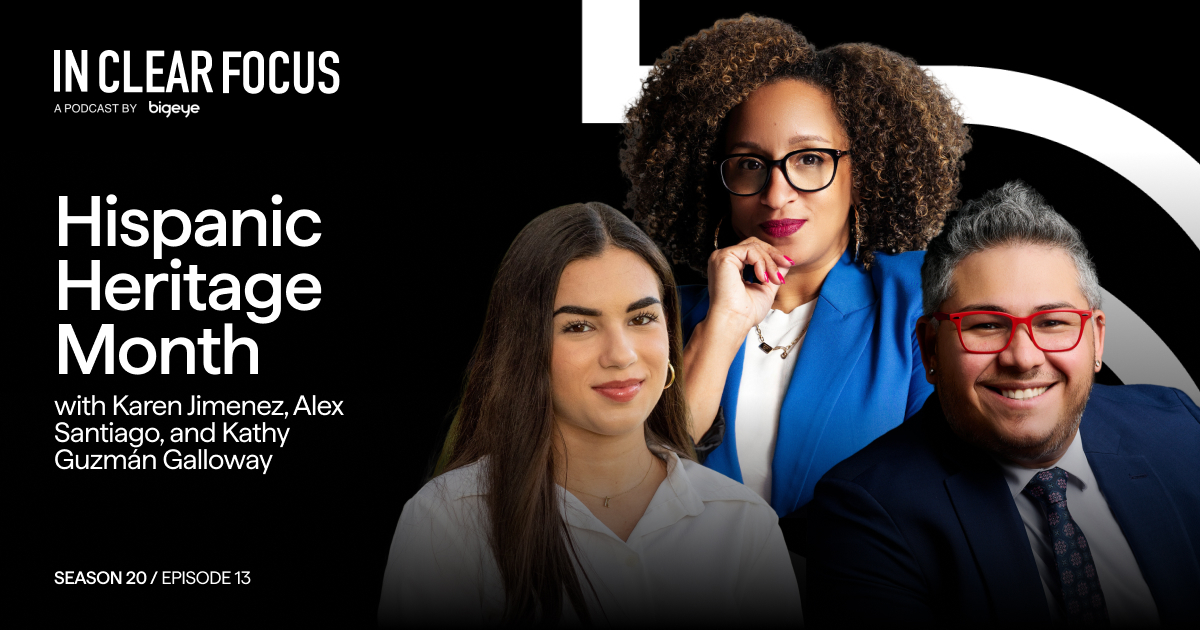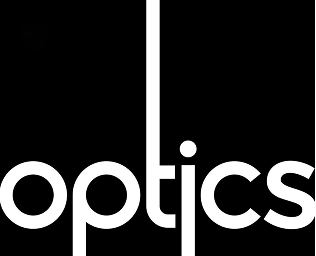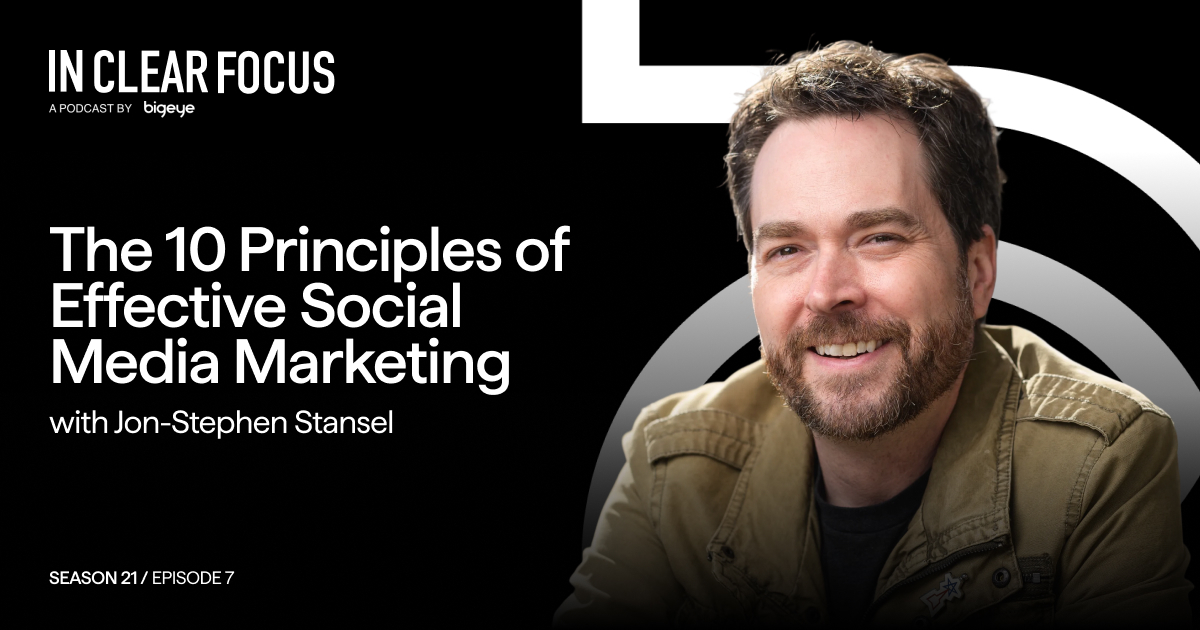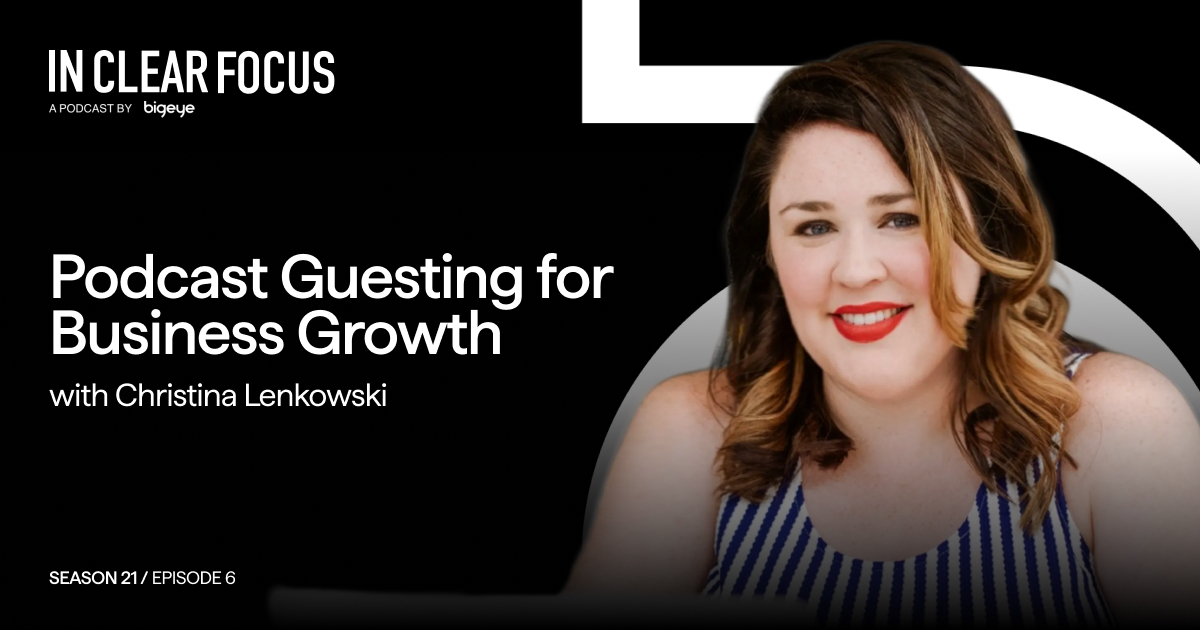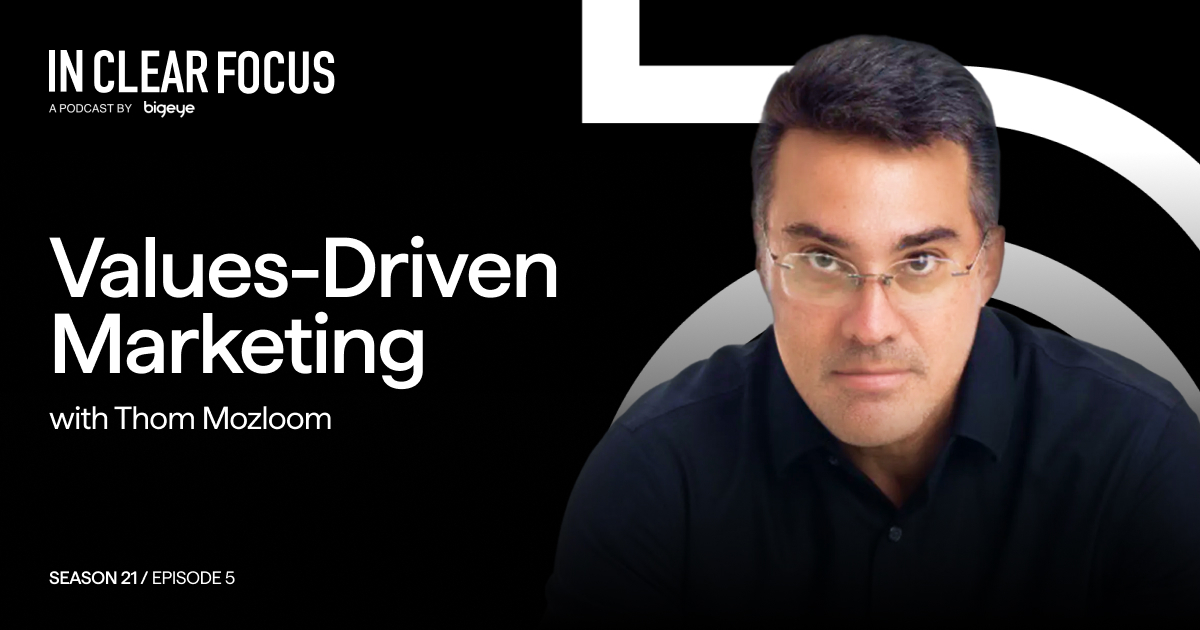IN CLEAR FOCUS: To mark Hispanic Heritage Month, strategists Kathy Guzmán Galloway and Alex Santiago join host Karen Jimenez to explore how brands can authentically connect with Hispanic consumers. They discuss why cultural context matters more than literal translation, the importance of diverse teams, and how consumer immersions uncover deep insights. Learn why “multicultural is mainstream” and how to move beyond superficial tactics to build genuine relationships with this influential audience.
Episode Transcript
Adrian Tennant: Coming up in this episode of IN CLEAR FOCUS
Alex Santiago: Cultural context matters because the greatest insights are born out of culture. Translating an idea into another language might do the job, but it might mean nothing for the audience.
Kathy Guzmán Galloway: It’s not enough to understand them at the superficial level, like here’s what we know about Hispanics. It’s actually important to understand them in the context of your category.
Karen Jimenez: You’re listening to IN CLEAR FOCUS: fresh perspectives on marketing and advertising, produced weekly by Bigeye: a strategy-led, full-service creative agency growing brands for clients globally. Hello, I’m Karen Jimenez, interning with Bigeye’s Strategy team, and I’m your host for today’s podcast. Thank you for joining us. To coincide with Hispanic Heritage Month, today’s episode explores how brands can more authentically connect with Hispanic consumers. At over 68 million people, Hispanics are the second-largest ethnic group in the United States, contributing a Gross Domestic Product of 3.6 trillion dollars, which is the world’s fifth-largest GDP if measured separately. Yet, despite this scale and impact, brands dedicate only about 4% of U.S. ad budgets to this audience. For brands that design and produce ads in English, literal translation into Spanish often misses cultural nuances, humor, and Hispanic identity. Today, we’ll explore what it takes to sharpen brand positioning for diverse audiences, identify some of the common mistakes brands make when trying to be inclusive, and hear practical tips for those just starting out in their marketing careers. To discuss these topics with me are two guests who have both appeared previously on IN CLEAR FOCUS. Alex Santiago is an award-winning creative strategist, founder of Social Mosaic Communications, and Head of Membership and Creative Direction at Ashley Gibson Barrett Museum of Art at Florida Southern College. Kathy Guzmán Galloway is a seasoned consumer packaged goods strategist with over 20 years of experience at PepsiCo and consulting with major brands to clarify their positioning. She’s known as The Clarity Wizard. To kick off the conversation, I’m joined first by Kathy. Welcome to IN CLEAR FOCUS! Can you tell me a little bit about your background and the work you’re doing today?
Kathy Guzmán Galloway: Yeah, thank you so much. I am a strategy consultant. I help consumer brands think about who their audience is, what they should say to them, and why those people should care. And I’ve been doing this well over 20 years now. Got my own company and my team. And prior to that, I was working in the CPG world for companies like PepsiCo and Dean Foods and a number of others. Yeah, this is what I do.
Karen Jimenez: Nice. Thank you for sharing. Why do you think so many marketers remain hesitant to invest in Hispanic audiences despite their size and buying power?
Kathy Guzmán Galloway: Yeah, I think a lot of that has to do with a fear of misunderstanding, a fear of feeling like the audience is so unique and specialized that it’s hard for me, for us as individuals to imagine them, to connect with them, to think about them, especially if you are not part of that group. And that is true for the Hispanic community, but it’s true for all of the underrepresented communities. We feel that We can’t personally connect with them and that leaves them a gap in the marketplace which honestly is the biggest driver of the opportunity the fact that you are really leveraging the opportunity to speak to the greater. population, as opposed to just narrowing down to non-Hispanic consumers, is something that they’re leaving on the table. And the biggest driver of that is non-diverse teams. The less you reflect the consumer, the less you know that you need to reflect them, the less you understand the differences between them, and the more you deprioritize the value in them.
Karen Jimenez: Yeah. Kathy, you’ve worked with global CPG brands. What lessons can packaged goods teach us about connecting authentically with Hispanic consumers?
Kathy Guzmán Galloway: Yeah, the thing that CPG does really well from the early days of CPG when Coke was established and some of those bigger brands are really coming to life is that over the years they have become experts at understanding an audience. That really what CPG and the consumer packaging industry as a whole can bring to every other industry in the world is an undying commitment to understanding their audience. Really doubling down and thinking about what are the drivers of behavior? What are the drivers of purchase? What are the drivers of appeal and of liking? So much so that anyone can pick up a playbook from the big CPG companies. You can walk in today to Procter & Gamble, to Coke, to Kraft, to PepsiCo, and take any playbook that they currently have on hand for how to execute against a particular market or particular audience, and anyone could execute it. And that is really due to the commitment, the depth of knowledge and understanding of the audience. And if we could relay that to other industries and really apply it at that same level of expertise, it would change everything, not only for the Hispanic consumers, But again, all the underrepresented audiences, they’re almost not visible. And with the Hispanic audience in particular, I think the language barrier, the element of the language starts to create even more hesitancy around that. And yet again, big CPG companies, they may not be dealing with language, but what they are dealing with is understanding the language of that moment. How does a consumer think about this? It may still be English, but the language is still foreign to me. If we can apply that same mental model to understanding the Hispanic consumer, it would really change the trajectory of this conversation in the United States.
Karen Jimenez: How does culture context often matter more than language accuracy?
Kathy Guzmán Galloway: Yeah, great segue from my last comment about the role of language and I would venture to say, I suppose I could be proven wrong, that there is no other underrepresented group as self-diverse. as a hispanic audience and often we use language as the defining parameter around this group of people and it is a false narrative while there is a baseline of language that has a lot to do with this audience and really plays a huge role. Even if the segments within the Hispanic community that you are talking to are not in and of themselves bilingual, language is still a big portion of that. But it lives in a cultural aspect much more than it does in a communication aspect. So it’s less about helping them understand what you are communicating and much more about being able to connect with them culturally and authentically. And if we could put a pin on language for a moment and think more about, so what does that language mean? What does that language do for this community? How do they leverage the language? We discover that it’s really about the broader messages and the broader values of the community that are showing up in language. Even when we think about what I love to call, been talking about for 25 years since I was a young girl, talking about Spanglish, and what is Spanglish and the role of Spanglish, and how brands are often throwing Spanish into advertising in an attempt to connect. And the problem there is again is the gap in understanding what is Spanglish? Why do we use it? How does it fit in? Where does it fit in more versus less? I would point you to Spanish language and actually Spanish or English language radio stations in high Hispanic population areas. I was just in New York a couple of weeks ago and love listening to the radio. I grew up on the East Coast, of course, I’m going to all my old radio stations, but you will quickly discover that the way that those consumers live is in a constant influx of English and Spanish. And the entire purpose of Spanglish or our attempt to use it, first and foremost, is to enable communication between us. Because honestly, sometimes I just can’t remember a word in English. It just does not come to me. All I have is the Spanish word. I will then use more words around that word to help us understand each other. And so it’s not about the word at all. It’s about my attempt to reconcile two parts of my brain in order to effectively communicate with you. And if we are two, three, four Hispanics, Latino Americans sitting together, and someone is, like myself, from the Dominican Republic, someone else is from Mexico, another person from Uruguay or Venezuela, you are going to find that we have to use a range of words to just communicate with each other. And so coming back to cultural authenticity, and language really the thing to understand and build on is that it ultimately is a vehicle for us to communicate and connect with each other because at the end of the day, what we care most about is actually that we are from some common place. And the language is one thing that brings us together. And so finding these words, it helps us just feel more connected to each other. It’s not about being cool. It’s not a badge of honor. It really is about enabling conversation between generations of people who are flowing in and out of the language and leaning into who are they, what are they communicating, and why do they choose to do it that way is a more valuable question, a more valuable topic to understand than just trying to figure out how do I throw a few words into this? You can be successful with no Spanish words. It is not mandatory, right? It’s better that they’re not there than that you are being inauthentic.
Karen Jimenez: How can companies ensure that their creative process authentically reflects Hispanic perspectives?
Kathy Guzmán Galloway: Yeah, go and understand them. Spend the time to understand why they act, they talk, they think, they behave in this particular way. That is where the authenticity comes in. And it’s not enough to understand them at the superficial level, like here’s what we know about Hispanics. It’s actually important to understand them in the context of your category. So if you are selling coffee, there’s a lot of culture there for you to tap into. If you are selling plant-based meats, there may not be as much, but then you are looking for those early adopters who would lean more into that to identify where there’s something there. So it’s really about spending the time with the audience and then doing it within the context of your product, your category, or whatever the key message is that you are trying to bring through. And one of the easiest ways to bring that to life for your team is with consumer immersion. So my team does quite a bit of these, where we will take a group of folks from an organization, three, four, five, six, sometimes 10 or 12 people from an organization, and we will curate a day or up to three days’ worth of immersion with a particular consumer. So a couple of years ago, I did that for a brand that was developing innovation targeted to the Hispanic audience in particular, and we spent three days in the LA area. So one day we did market tours where we were going into what are local markets where the people actually shop day to day, talking to the folks at the stands, talking to guests and shoppers that are there. Then we spent another day where we were going through actual retail stores in the neighborhoods where the people are that we are targeting, and looking at what kinds of products are there, and even doing some intercepts right at the store, asking people, “I see that you’re picking up these products, why are you buying them? Who are they for? Why do you shop at this store?” Really trying to get to know them. And the third was a sort of “Live a Day in the Life.” And here we recruited some consumers, where we just followed them around. Wake up early, you’re getting ready for work, we’re seeing how you’re prepping your family or your lunch, we go with you in your car, drive to your job and kind of observe you doing what you do. And really learning about their day-to-day life beyond what happens at home. And that was just really powerful because the team was able to not just see words on paper. There’s a thousand YouTube videos you could watch, there are syndicated reports, but that is not the same thing as sitting next to someone during their lunch break and enjoying a meal that they prepared and talking to them about why they’re eating what they’re eating and what they plan to do with the rest of their day. It’s just it’s a whole other level. So if someone is thinking about how do we go to that next level with the Hispanic audience or any underrepresented audience, a consumer immersion is highly recommended.
Karen Jimenez: I really like that. Kathy, you said multicultural is mainstream. What do you mean by that exactly?
Kathy Guzmán Galloway: Yeah, these days everybody’s talking about Gen Z. Anything between Millennials and Gen Alpha, which is the bulk of the buying population in America. Not to ignore my Gen Xers or folks older than us, but Millennials and younger are the most diverse population we have ever seen in really, I believe, the history of the world. And that we finally really started to see the melding of people and cultures and races, such a deep level. And so to say I am gonna target anyone under the age of 40 and ignore that anyone under the age of 40 has a good chance of being a person of color is to ignore the fact that people are shopping on social media, or to ignore the fact that we have smartphones. That’s like saying, “Well, yeah, some people have smartphones, some people don’t.” So to ignore multiculturalism and not even acknowledge, even in the product services that you offer today, is a disservice to your brand and to your business. There is no multicultural marketing anymore because all of it, by definition, it is multicultural marketing. So if that phrase, that term, that concept is not floating around in your organization, you’ve already lost the game. You’re about 10 years behind in that process. So that just isn’t a thing anymore.
Karen Jimenez: Thanks to Kathy for those great insights. We’ll continue the conversation about Hispanic consumers with our next guest, Alex Santiago. We’ll be right back after this message.
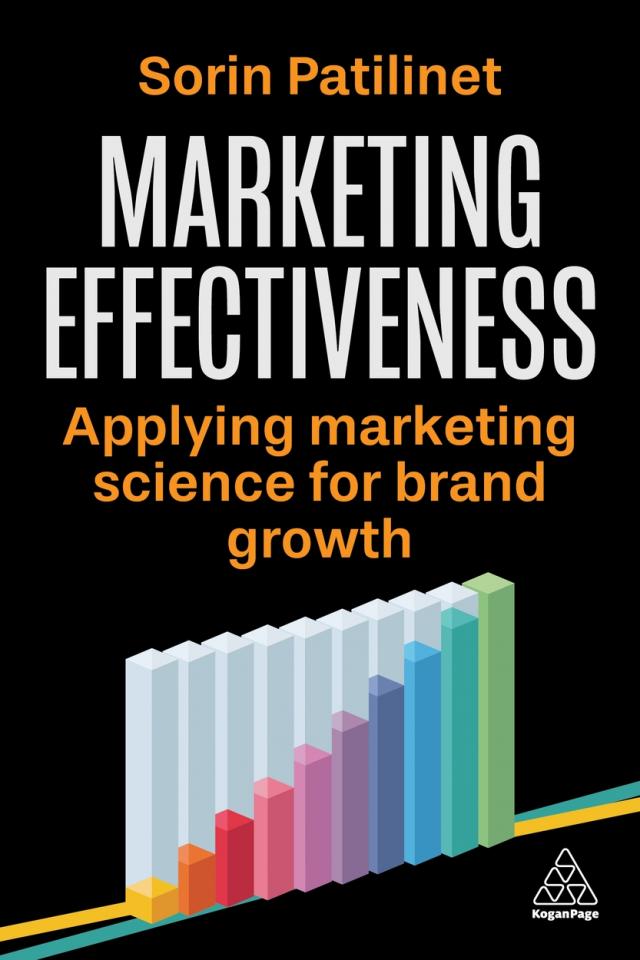 |
Sorin Patilinet: Hello, I’m Sorin Patilinet, the author of Marketing Effectiveness: Applying Marketing Science for Brand Growth published by Kogan Page.
Drawing on my over 20 years of experience, I reveal how marketers can bridge the gap between creativity and analytics to drive sustainable growth. Whether you’re a mid- to senior-level marketeer facing pressure to deliver quantifiable results, or someone looking to integrate advanced measurement into your marketing strategies, my book provides practical frameworks and real-world examples from brands like Snickers, Unilever’s Dove, and M&M’s. You’ll discover how to leverage neuroscience or machine learning to deepen customer understanding, navigate AI’s evolving role in marketing, and lastly, develop the skills needed to thrive as a modern marketeer. As an IN CLEAR FOCUS listener, you can save 25% on Marketing Effectiveness when you order directly from KoganPage.com. Just enter the exclusive promo code BIGEYE25 at checkout. Shipping is always complimentary for customers in the US and the UK. I hope my book helps you apply marketing science to create measurable success and elevate your marketing career. Thank you! |
Karen Jimenez: Welcome back. I’m Karen Jimenez, Strategy intern with Bigeye, and this week we’re talking about Hispanic consumers. Joining me now is our next guest, Alex Santiago. Alex, welcome back to IN CLEAR FOCUS. Can you tell me a little bit about your background and the work you’re doing today?
Alex Santiago: Thank you so much for having me. I am currently working for a non-profit in Lakeland, Florida. I am the membership manager for the AGB Museum of Art, and I am the founder and owner of Social Mosaic Communications, which is my branding consultation company, also here in Lakeland, Florida.
Karen Jimenez: Nice. And why do you think so many marketers remain hesitant to invest in Hispanic audiences despite their size and buying power?
Alex Santiago: It’s a really good question. I think that this is due to the current climate today, there’s a couple of reasons. Some companies are just ignorant to that buying power, right? We might be aware of the buying power. It might just be a lack of awareness and understanding of the buying power of the Hispanic community, LatinX community in the United States. I think that on the other side, there are a lot of brands and companies that are fundamentally afraid of messing up. They’re just concerned and afraid about doing something wrong, getting something wrong, saying something wrong.
Karen Jimenez: Yeah, it’s really interesting. I definitely agree with your perspective. Alex, why does culture context often matter more than language accuracy when it comes to certain campaigns with brands?
Alex Santiago: I love it. That is a great question. Cultural context versus only language. That is something that is interesting because that has been the hardest part in my bilingual copywriting experience that I’ve had. Cultural context matters because the greatest insights are born out of culture. The greatest campaigns usually either reflect or revolutionize culture translating an idea into another language my do the job but it might mean nothing for the audience so cultural context is important because you’re essentially telling that specific audience whether Hispanic, African American, is in America and you’re essentially saying “You matter to us, we’re paying attention to you, and we want you to engage with this company with his brand with this product in some form.” A way that you showcase that you are invested in bringing them value, and at the end of the day, the matter the audience having cultural context it’s just what moves great creative forward.
Karen Jimenez: Yeah, I like that perspective. Just elaborating on that, what are common mistakes brands make when they rely only on translation?
Alex Santiago: So relying on translations is dangerous because nuance gets lost within languages. I think that relying on a translation is relying on an idea that Latin people are a monolith and there’s a singular Spanish or there’s a singular language. The United States does this thing where like the idea of the melting pot like erases nuance. So relying on translation is essentially stripping away cultural nuance cultural detail and honestly it’s funny because I believe that it destroys creativity it takes away your ability to really, be special or showcase that you have your post in culture for example if you have a product that you know is very Mexican American-centric vs. native, you know, a Mexican, you’re losing the ability to connect with one versus the other, even though in people’s brains, you’re just Mexican, right? You’re a Mexican in this country. You’re doing things that affect people en masse, leading, making decisions through an ignorant level or a singular mindset is just dangerous and ineffective.
Karen Jimenez: Yeah, I definitely see your point of view, and I agree with that for sure. Alex, in your book, “Stop Asking for Logos,” you write about brand filters and humanizing brands. How does transcreation connect to that philosophy that you mentioned?
Alex Santiago: Oh man, that’s awesome, you read the book! Basically, a lot of my passion for the ad industry was in bringing an outsider perspective into things. And I realized that if everyone is an outsider, if everyone has their own little trademark on thinking, you’ll have a hard time connecting. So having a unique mindset becomes divisive when you’re trying to bring people together. Essentially, I started finding ways to speak about our industry in an inclusive way. And what that means was everyone understood what a filter does, right? Like you understand that a filter keeps your air clean, whether that’s in your car, in your home, you understand everyone has somebody. That you say, “Oh, my aunty has no filter or my Tío has no filter, right?” SNL just did a whole bit on the ChatGPTío because they have no filter, right? Historically, traditionally. So everyone understands what having a filter means, and everyone feels and understands what not having a filter does. So basically for me was I created this notion that strategy is a filter for the business to help you make decisions. Because the thing about a business is that you literally have, even if it’s just a two-person team. That’s two brains to perspectives to realities so when you’re talking about corporations, you’re talking about global brands, it is a lot harder for people to align. So I can always notion of strategy filters and then the other side message filters for communications and how you actually speak. To an audience with a B2B, B2C, whatever that is, so how that connects with humanizing brands is that we show up differently based on the cultural need the moments need and that’s what great creative can do you have a big idea on one side so if you can humanize the brand. That brand can show up to no matter what room you put them in they can show up and be true to themselves first and foremost because you got branches what you believe in how you behave and then you can actually connect with an audience based on the needs of that moment especially when you start getting into micro moments which is right like google has famously made part of our everyday we’re making this tiny micro decisions. Throughout the day we’re hungry, we’re driving on a vacation, and all the sudden you’re like “What’s the x place nearest me?” So now location matters and displays matters, something that’s interesting is like, if you are a real estate agent – which I have done a couple of – if you’re building a brand, your community is fundamentally different than the American community. So like that makes your decision of like, do you want to be a national player? Do you want to be a regional player or a local player? Right? Like showing up for each one of those places is fundamentally different. And that’s what my book essentially was trying to say that you can, in fact, create in a way that helps you be flexible and helps you connect with audiences in a way that matters to them, not the way that you want to show up in.
Karen Jimenez: How can companies ensure that their creative process authentically reflects Hispanic perspectives?
Alex Santiago: I think this is why strategy has become such an important part of the modern communications models. You cannot fake culture. That’s the truth of the matter. It’s like SNL just did something that it would have been impossible for anybody else to even dream of, right? SNL just released a riff on El Chavo Del Ocho. So you know that it’s fundamentally, this was for Latinos, right?
Karen Jimenez: Yeah.
Alex Santiago: So like you have something that was clearly two Latin men writing a bit for Latin people, but it’s also making fun of themselves. People don’t realize that you’re making fun of yourself because by translating the names is actually showcasing how ridiculous the show actually was to begin with. And it’s all happening within culture, right? So like the marriage of cultures, and then a sketch show making fun of an actual sketch show. And then you try to find out where do they meet with each other? Because you know that the big idea is going to live somewhere in that sweet spot, right? And that’s very traditional advertising for you advertising geeks out there with me. So finding the sweet spot when it comes to culture, it’s simple, but I believe that strategies just have such a big job in making sure that teams understand that culture that they’re going after. So. I believe that strategies are key and then creators are key because then understanding culture and presenting culture and insight is very important, but then finding yourself like writing like the people, right? Like finding the voice of a community and then making it make sense within your present culture, right? I think that’s the part that’s really interesting. So you’re going to try to find something that is going to connect with all the people and that’s where you start refining. For example, going back to the travel because it’s so relevant at this moment.
Karen Jimenez: Yeah.
Alex Santiago: So Marcelo, who is playing El Chavo in that moment, says, “My mom said.” It’s funny because he is famously doesn’t have parents, right? Like that is one of the key parts of this character is that he’s an orphan, right? He’s an orphan. He has no adults in his life. He’s the sweetest kid, but he’s an orphan. So I was like, “Oh man, because he would never say that ‘my mom says.’ Everybody’s confused. She’s so stupid. It makes no sense. But for SNL, it’s awesome because that’s what they do.” You have to be aware so that you do not alienate. Obviously, you don’t want to follow tropes and be racist. You don’t want to anger whole communities of any kind, right? But it’s very, very beneficial to come up with bigger, richer ideas when you do have that insight and you have that understanding, the nuanced understanding of culture, right?
Karen Jimenez: Alex, you’ve coached young professionals for years. What excites you about the next generation of multicultural marketers?
Alex Santiago: What’s exciting is that they are growing up in multicultural settings, that no matter how divisive mass media right now presents us, the reality is that young people are growing up with more nuance than ever. My kids are prime example of that, but a lot of the students and the young adults who I work with, they are far more aware and exposed to other cultures. Oftentimes, because they are digital natives, even broader than just their surroundings. But in their surroundings specifically, I think that is more meaningful because they’re understanding that nuance a lot better because they’re experiencing it firsthand. So yeah, I have great hope. Because no matter the noise that all of these, you know, older generations keep making and the divisiveness strategies that keep happening in all types of media, what I see in youth is actually it is inclusivity. It is cultural awareness. And honestly, it’s just, they want better, just like we want it better. And the people before us want it better and we’ve all been getting better, but the pendulum is so strong that. We can get lost in the small increments that happen as far as like having more access, having better relationships, things like that.
Karen Jimenez: Yeah. Thank you for sharing that. Alex, thank you very much for being our guest this week on IN CLEAR FOCUS.
Alex Santiago: Thank you so much, you guys. It means the world that I’m here today with you.
Karen Jimenez: Thanks again to my guests this week, Alex Santiago and Kathy Guzman-Galloway. As always, you’ll find a complete transcript of our conversation with Timestamps and links to the resources we discuss on the IN CLEAR FOCUS page at Bigeyeagency.com. Just select ‘Insights’ from the menu. Thank you for listening to IN CLEAR FOCUS, produced by Bigeye. I’ve been your host, Karen Jimenez. Adrian Tennant will be back next week for the start of the 21st season of IN CLEAR FOCUS, but from me, goodbye.
TIMESTAMPS
0:00: Introduction to Cultural Context in Marketing
0:28: Hispanic Heritage Month and Market Insights
1:43: Guest Introductions: Kathy Guzman-Galloway and Alex Santiago
2:24: Kathy’s Background and Role in Strategy Consulting
3:02: Understanding Marketer Hesitance Towards Hispanic Audiences
4:12: Lessons from CPG Brands on Audience Connection
6:27: The Importance of Cultural Context Over Language Accuracy
10:48: Ensuring Authentic Representation in Creative Processes
13:52: Multiculturalism as the New Mainstream
15:30: Introduction of Alex Santiago
17:04: Alex’s Background and Work
17:31: Marketer Hesitance: Ignorance vs. Fear
18:16: Cultural Context vs. Language in Campaigns
19:22: Common Mistakes in Relying on Translation
20:48: Transcreation and Humanizing Brands
23:44: Authentically Reflecting Hispanic Perspectives
26:14: Excitement for the Next Generation of Multicultural Marketers
27:37: Conclusion and Thanks to Guests
